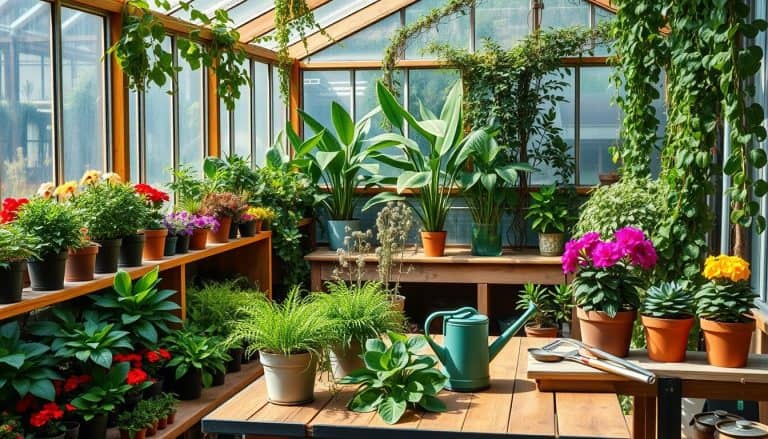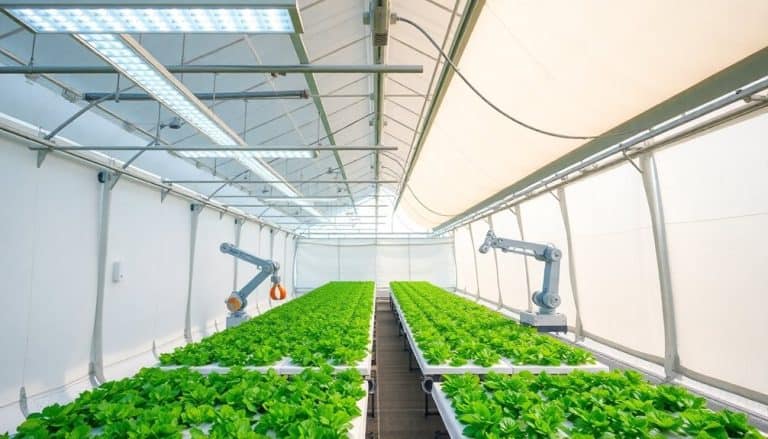This website contains affiliate links. Some products are gifted by the brand to test. As an Amazon Associate, I earn from qualifying purchases. The content on this website was created with the help of AI.
Greenhouse gardening articles are shared 7,500 times on average. This shows a growing interest in greenhouse cultivation among new gardeners. Our guide will help you start your greenhouse journey.
Greenhouses have evolved since their 17th-century beginnings as brick shelters. Now, they’re advanced spaces for year-round plant cultivation. They benefit both commercial growers and home gardeners.
This guide covers the basics of greenhouse gardening. We’ll discuss choosing locations, selecting plants, and creating optimal growing conditions. You’ll learn about temperature control, lighting, and soil preparation.
A greenhouse offers many benefits for gardeners. It extends the growing season and protects plants from pests. You can even grow exotic species in your own backyard.
Greenhouses allow for year-round plant cultivation. With the right setup, you can grow a variety of plants regardless of the season.
Key Takeaways
- Greenhouse gardening is gaining popularity, with articles shared 7,500 times on average
- Greenhouses evolved from simple shelters to controlled environments over centuries
- Temperature control and lighting are crucial for successful greenhouse growing
- Proper location and foundation are essential for optimal greenhouse performance
- Greenhouses allow for year-round cultivation of various plant species
- Choosing the right size greenhouse is important for versatility and future growth
- Beginner-friendly plants include radishes, peas, lettuce, and tomatoes
Understanding Greenhouse Basics and Benefits
Greenhouses open up exciting possibilities for gardeners. They create a controlled environment where plants thrive. These structures benefit both new and seasoned growers alike.
What is a Greenhouse
A greenhouse is a special structure that creates an ideal plant growing environment. It traps sunlight and heat, keeping the inside warmer. This allows gardeners to grow various plants, no matter the outdoor weather.
Key Benefits of Greenhouse Growing
Greenhouses offer many advantages that can boost your gardening success:
- Extended growing seasons
- Protection from harsh weather
- Improved pest control
- Ability to grow tropical or rare plants
- Better management of temperature and humidity
How Greenhouses Work
Greenhouses trap sunlight and heat. This creates a warmer environment inside, often several degrees higher than outside. The controlled setting allows precise management of growing conditions.
Gardeners can adjust light, temperature, and humidity as needed. This level of control leads to healthier plants and better yields.
| Greenhouse Component | Function |
|---|---|
| Transparent walls and roof | Allow sunlight to enter |
| Insulation | Retains heat |
| Ventilation system | Regulates temperature and humidity |
| Heating system | Maintains warmth during cold periods |
Knowing these greenhouse basics helps gardeners create the best growing conditions. This knowledge leads to healthier plants and higher yields.
Choosing the Perfect Greenhouse Location
The right greenhouse spot is key for healthy plants. Let’s look at important factors for placing your greenhouse.
Sunlight Requirements
Sunlight is vital for greenhouse plants. Place your structure to get the most light. In the North, a south-facing wall gives sun all year.
The greenhouse ridge affects light spread. East-west ridges maximize light in dark months. North-south ridges give equal light for spring and summer use.
Protection from Elements
Shielding your greenhouse from harsh weather is crucial. Put it near houses or fences to block high winds. For safety, try these options:
- Wooden greenhouses with shatterproof UV-treated styrene for child safety
- Maintain a 1-meter space around the perimeter for maintenance access
Accessibility Considerations
Pick a spot that’s easy to reach for daily care. Think about these factors:
- Proximity to water sources for easy irrigation
- Access to power outlets for heating and ventilation systems
- Level ground or easily modifiable surface for a stable foundation
| Greenhouse Size | Growing Space | Ideal Soil Composition |
|---|---|---|
| 20-25 sq ft per person | For family vegetable gardening | 60% loam, 30% compost, 10% mulch |
Think about these factors to create a perfect home for your plants. Your greenhouse will help them grow strong and healthy.
Types of Greenhouses for Beginners
Greenhouses have evolved since their 17th-century origins. Today, we have many options to fit different needs and spaces. Let’s look at some popular choices for new gardeners.
Hobby greenhouse kits are a great way to start. They come in various sizes and are easy to set up. It’s smart to choose a kit slightly larger than you think you need.
This gives you room for more plants and supplies as you improve your skills. Portable tented shelf greenhouses work well in small spaces like balconies or patios.
DIY fans might enjoy building custom greenhouses. They can use materials like special plastic or old windows.
| Greenhouse Type | Material | Pros | Cons |
|---|---|---|---|
| Polycarbonate | Plastic panels | Affordable, durable, good insulation | Less attractive than glass |
| Glass | Glass panels | Traditional look, wide variety | More expensive, fragile |
| Plastic | Plastic sheeting | Cheapest option | Less durable, needs frequent replacement |
| Steel Frame | Steel structure | Most durable, ideal for windy areas | Highest cost |
When picking a greenhouse, think about sunlight and wind protection. A sturdy foundation is also important. These factors help create a stable environment for your plants.
This applies to both kit and DIY greenhouses. Choose the option that best fits your space and gardening goals.
Essential Greenhouse Setup and Foundation
A solid foundation is key to a successful greenhouse. We’ll explore foundation, flooring, and layout options. These elements create the perfect growing environment for your plants.
Foundation Options
Choosing the right foundation ensures stability and longevity. Concrete slabs offer durability and easy upkeep. Wooden frames are flexible and budget-friendly.
Gravel beds excel in drainage and cost-effectiveness. Your choice depends on budget, climate, and greenhouse size.
Flooring Materials
Flooring impacts cleanliness, drainage, and plant health. Concrete floors are easy to clean but can be cold. Gravel allows excellent drainage and helps control humidity.
Wooden floors offer warmth but need more maintenance. Consider your specific needs when picking flooring materials.
Internal Layout Planning
An efficient layout maximizes your greenhouse space. Plan for shelving, benches, or raised beds based on your growing goals. Leave room for storage and work areas.
A well-designed layout boosts productivity and makes greenhouse tasks more enjoyable.
| Foundation Type | Pros | Cons |
|---|---|---|
| Concrete Slab | Durable, easy to clean | Expensive, poor drainage |
| Wooden Frame | Affordable, flexible | Requires maintenance |
| Gravel Bed | Excellent drainage, cost-effective | Less stable, can be uneven |
A flat, firm surface is ideal for your greenhouse. Proper planning creates a thriving environment for your plants year-round.
Temperature Control and Ventilation Systems
Optimal greenhouse temperature control is vital for plant growth. We’ll explore heating, cooling, and ventilation methods for an ideal plant environment.
Heating Solutions
Greenhouse heating extends the growing season. Electric or gas heaters are common choices. Propagating heating mats offer energy-efficient seed starting.
Smart controllers automate heating systems. They maintain temperatures between 80-85°F (27-29°C) for optimal plant growth.
Cooling Methods
Effective cooling is crucial during hot months. Evaporative cooling systems work well in dry climates. Shade curtains and light deprivation sheets control light exposure and temperature.
Horizontal airflow fans distribute temperatures evenly. They enhance grow room conditions for better plant health.
Ventilation Requirements
Proper greenhouse ventilation regulates temperature and humidity. Side and roof vents should be adjustable for ideal growing conditions. Experts recommend vent areas equal 15-20% of the floor area.
Fan systems are crucial for air circulation. A 25×96 foot greenhouse needs fans with 19,200 cubic feet per minute capacity. Choose fans tested to industry standards for reliable performance.
| Ventilation Component | Recommendation |
|---|---|
| Wind Speed | 2-3 miles/hour for 80% ventilation |
| Vent Area | 15-20% of floor area |
| Air Exchange Rate | One volume per minute to 8 feet height |
| Temperature Rise | 8-10°F from intake to fan |
These temperature control and ventilation strategies create an optimal greenhouse environment. Your plants will thrive year-round with these methods in place.
Greenhouse Lighting Requirements
Greenhouse lighting is vital for plant growth. While greenhouses use natural sunlight, extra lighting is often needed. This ensures plants get enough light year-round.
Proper lighting helps plants thrive through photosynthesis. Let’s look at key aspects of greenhouse lighting. This will help you create the best environment for your plants.

Grow lights keep plants healthy, especially in winter. They’re also crucial for plants that need lots of light. Two light spectrums are key for plant growth:
- Blue Light (425-450 nanometers): Promotes vegetative growth
- Red Light (600-700 nanometers): Enhances flowering and fruit production
When setting up greenhouse lighting, consider these factors:
- Light Duration: Most plants need 13-16 hours of light daily.
- Light Distance: Place grow lights 6-30 inches from plant leaves.
- Light Coverage: Make sure light is evenly spread in your greenhouse.
Picking the right grow lights is crucial. Here’s a comparison of popular options:
| Light Type | Efficiency | Lifespan | Heat Output | Spectrum |
|---|---|---|---|---|
| LED Lights | High | Long | Low | Full |
| T-5 Fluorescent | Medium | Medium | Low | Limited |
| HID Lights | High | Medium | High | Specific |
LED lights are gaining popularity for greenhouse use. They’re energy-efficient and long-lasting. LEDs also provide balanced light for all plant growth stages.
Understanding these lighting needs helps create ideal conditions for plants. This knowledge ensures healthy growth in your greenhouse.
Soil Preparation and Growing Medium
The right greenhouse soil is crucial for plant growth. We’ll explore soil testing, amendment tips, and container options. These elements help create the perfect growing medium.
Soil Testing Methods
Regular soil testing maintains optimal greenhouse conditions. Conduct a 1:2 water extract analysis every 3 months to assess soil health. This test determines pH levels and measures electrical conductivity (EC).
Ideal pH levels range between 6 and 7 for most plants. EC indicates salt content that affects plant growth.
Soil Amendment Tips
Soil test results guide amendment needs. For balanced greenhouse soil, mix 60% loam, 30% finished compost, and 10% bark mulch or coconut coir.
Add lime to increase alkalinity or sulfur for acidity. Organic fertilizers address specific nutrient deficiencies revealed by soil tests.
Container Options
The right containers impact plant health. Raised beds and individual pots offer better control over soil conditions. Use plug mixes with a 2:1 water to dry substrate ratio for seedlings.
Different growth stages require varying fertilizer concentrations:
| Growth Stage | Nitrogen (ppm) |
|---|---|
| Germination | 0 |
| Cotyledon opening | 25-50 |
| First true leaves | 50-100 |
| Transplant ready | >100 |
These guidelines for soil preparation create an ideal environment for greenhouse plants. Your plants will thrive with the right growing medium and care.
Watering Systems and Humidity Control

Efficient watering systems are vital for greenhouse gardening success. Let’s explore various options to help you pick the best method. Your plants will thank you!
Drip irrigation systems deliver water straight to plant roots. They minimize waste and prevent leaf wetness. These systems are scalable and offer precise water distribution.
Drip irrigation works well for any size greenhouse. While they need electricity for pumps, their water conservation benefits are substantial.
Self-watering trays and capillary mats suit smaller greenhouses well. They encourage deeper root growth and create a humid atmosphere. However, they may restrict growing medium choices.
Misting systems provide timed and automated watering for larger greenhouses. They’re great for propagating seedlings and can lower greenhouse temperatures. Proper management prevents wasteful water use.
| Watering System | Pros | Cons |
|---|---|---|
| Drip Irrigation | Water-efficient, precise distribution | Requires electricity, potential nozzle clogging |
| Self-watering Trays | Promotes deep roots, humidity control | Limited growing medium options |
| Misting Systems | Automated, temperature control | Potential water waste if mismanaged |
Humidity control is crucial in greenhouse management. Most plants thrive at 80% humidity and 80°F (27°C). Too much humidity can cause fungal diseases.
Low humidity may dry out plants and stunt growth. To maintain ideal humidity, avoid overwatering and improve ventilation. Use dehumidifiers when needed.
Balancing watering systems and humidity creates the perfect environment. Your greenhouse plants will flourish with the right conditions. Happy gardening!
Best Plants for Greenhouse Beginners
Starting a greenhouse can be thrilling. Here’s a list of easy-to-grow plants for beginners. These plants thrive in greenhouse settings and are perfect for new gardeners.
Easy-to-Grow Vegetables
Salad veggies are great for new greenhouse gardeners. Tomatoes, peppers, cucumbers, and lettuce yield plenty in spring and summer. They love the controlled climate of a greenhouse.
Cold-hardy veggies extend your growing season. Onions, carrots, kale, and broccoli provide fresh produce even in colder months.
Recommended Starter Plants
Herbs are perfect for greenhouse newbies. Basil, cilantro, oregano, and mint flourish in frost-free spaces. They’re easy to care for and add zest to your cooking.
For pretty blooms, try geraniums, African violets, or begonias. These plants adapt well to greenhouses and flower year-round.
Year-Round Growing Options
Mix up your greenhouse with different plant types. Strawberries are easy to grow and fruit for long periods. Spinach and chard are great for winter harvests.
Try growing citrus fruits or tropical plants indoors. With care, you can enjoy diverse plants all year. This maximizes your greenhouse space.
Greenhouse Maintenance and Care
Greenhouse maintenance is crucial for successful growing. Daily checks on temperature, humidity, and ventilation keep plants thriving. Use beneficial insects or organic pesticides for pest control.
Good sanitation prevents disease spread. Clean and sterilize your tools often. Regular inspections help catch plant issues early.
Prune dead or sick plant parts immediately. Rotate crops to avoid soil depletion and pest buildup. Give plants enough space for proper air flow.
Deep clean your greenhouse at season’s end. This prevents pests from overwintering and reduces diseases. Wash all surfaces with soapy water and oxygen bleach solution.
Don’t forget to clean your irrigation system. With proper care, your greenhouse will be ready for another growing season.




